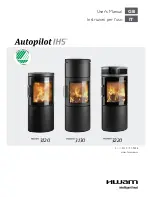
Other factors affect the draught:
- Houses with extremely indoor insulation, without air currents: with no air entering
the stove, the draught is affected. This is correct by sending air from outside to the stove.
- Trees and/or tall buildings close to the home.
- The wind speed. Generally, persistently strong winds increase the draught,
although stormy winds may decrease the draught.
- Outside temperature. The colder it is outdoors, the better the draught.
- Barometric pressure. On rainy, humid or stormy days, the draught is generally
weak.
- Liveliness of the fire. The hotter the fire, the stronger the draught.
- Cracks in the chimney, a badly sealed or dirty door, air inlets through the pipe joints,
other appliance connected to the chimney, etc. may produce unsuitable draughts.
2.- Creosote formation and cleaning
When wood is burned slowly, tar and other organic vapours are produced that, when
combined with atmospheric humidity, form creosote. The creosote vapours can be
condensed if the chimney walls are cold. If the creosote catches alight, extremely hot fires
may be caused. Any accumulation of creosote must be immediately removed.
Due to the accumulation of creosote depending on many variables, it is very difficult
to predict the moment at which the chimney must be cleaned. A visual inspection is the
safest way of knowing whether the chimney of your stove is clean.
We therefore recommend installations to which access is easy.
3.- Options
If you are going to build a chimney for your HERGÓM stove, you have two
alternatives:
a) Brickwork chimneys.
b) Metal chimneys
Studies reflect that there is no great difference between metal and brickwork in terms
of draught. It is you who, according to each case, will choose one or another.
Whenever possible, place your chimney inside the home to obtain a better draught
and accumulate less creosote, leading to a longer working life.
The advantages of brick chimneys are:
•
The mass of bricks and tiles reduces the cooling of smoke in the chimney.
•
The characteristics of the bricks in accumulating heat allows for the house to
remain warm for longer after the fire has been put out.
•
It may be built to individual tastes.
•
If it is well built, it may be more fire-resistant than metal chimneys.
Brickwork chimneys must be well lined to avoid smoke cooling. They must be built
using materials that withstand high temperatures and corrosion. They may be round,
square, etc. What matters is their size.
For brickwork chimneys in these models of HERGÓM stoves, the following
measurements must be respected:
- Round chimney with a diameter of 150 mm.
- Square chimney 175 x 175 mm.





































